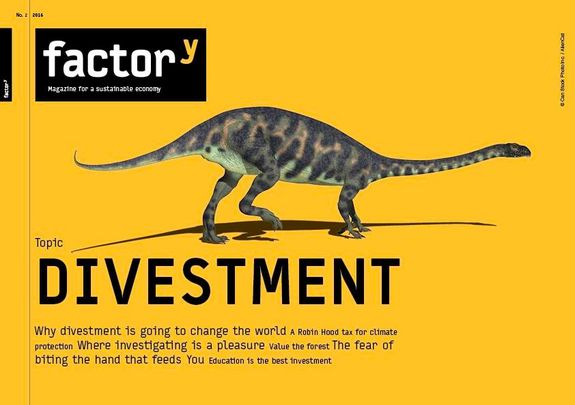Divestment

Taxes on the environmentally-harmful gas CO2 make investing in the fossil economy less worthwhile. Countries could channel revenues towards sustainable economic structures and their population. CO2 taxes solve social problems and save the climate, but is it too good to be true?
By Susanne Götze
Translated from the German by Vanessa Waigum, Nicole Wieden, Armin Deiri, Fenja Behrmann, Melinda Kaiden, Anneka Faiß and Eliot Reiniger
The globalisation-critical organisation Attac was founded in the late 1990s with a specific political objective in mind: the introduction of a financial transaction tax. This tax was supposed to put an end to speculations and help the world’s poor. When the Der Spiegel (a German magazine) devoted a cover story to the organisation after the anti-capitalism protests in Seattle (1999) and Genoa (2001) and everybody in Germany and Europe was suddenly talking about anti-globalisation movements, the members of Attac felt misunderstood. They didn’t want to combat globalisation, but rather globalised exploitation. Even if the long-haired protesters with their batik t-shirts were reminiscent of the student protesters from 1968, there probably hasn’t been a simpler demand in the history of social movements than the introduction of a simple tax. Nevertheless, it took more than ten years and a severe financial crisis before the idea was seriously discussed at the top level of politics. Today, Angela Merkel talks about it as if the tax had been an idea of the German Christian Democrat Party.
The sad end of the story: while conservative governments adorn themselves with the tax, no one speaks of Attac anymore. There will be no revolution for now. Whether the long-awaited tax will ultimately make ‘a different world’ possible, weaken capitalism noticeably or put the world’s poor out of their misery is at least questionable under these circumstances.
This lesson of anti-globalisation activists still lies ahead of the world’s climate protectors. For some time now a growing number of scientists, environmentalists and economists have been vehemently demanding a tax on the environmentally-harmful CO2 that clogs the atmosphere and increases the temperature worldwide.
In front of 2,000 scientists in the plenary hall of the UNESCO headquarters in Paris, as well as in front of the factory magazine team, Ottmar Edenhofer, chief economist of the Potsdam Institute for Climate Impact Research (PIK), said: “We need to put a price on co2 – in the form of a tax.” Edenhofer made this statement in July 2015, around six months prior to the world climate conference. The climate economist explained in an eloquent and direct manner: “If I talk to politicians about a carbon tax, they do get my point. Yet they tell me that such a measure would be political suicide and then they proceed to do nothing at all.” Politicians' reactions during the 1990s must have been similar when financial transaction tax was being discussed. The principle of both concepts of taxation is the same: it aims to sanction the sources (of speculation or co2) while rewarding the public. It is not without reason that the tax proposed by the Attac network has also been called the Robin Hood tax.
&nb
Carbon dioxide comes with costs
However, all cross-border attempts to introduce a carbon tax have failed miserably so far – a phenomenon entirely in the tradition of the Robin Hood tax. However, the call to implement a price on co2 is growing slowly and steadily louder. While there was some haggling over climate targets (meaning the reduction targets regarding co2 emissions within a specific period of time) at the convention on climate change in Paris, economists such as Edenhofer believe that change in climate policy is still possible but only with a worldwide price on co2. Only if fossil fuels increase in price and therefore become unattractive will investors start to change their views because ultimately, this issue concerns their wallets. They will look for alternatives – at least in theory.
Reality reinforces Edenhofer's prediction: each year more carbon dioxide is being released into the atmosphere instead of being ‘decarbonised’. For a slowdown of global warming, almost 90 percent of the remaining carbon and more than 60 percent of all reserves of oil and gas would have to be left in the ground. At the convention on climate change in Paris, even industry representatives such as Sandrine Dixson-Declève, head of the Prince of Wales's Corporate Leaders Group, explained: “It is all about shifting these investments into production methods that involve little CO2 emission. Investments that highly depend on co2 emission are simply no longer an option. Executive boards, brokers and funds managers now have to start rethinking.”
In principle, no one rejects the idea of having a price on co2. In some countries like France, Sweden or Switzerland, there already are co2 levies or taxes. More than 40 countries have introduced pricing on carbon in some form or another. The debate still rages on among economists, politicians and environmentalists about whether a tax or a different market-based solution would be the better option. The alternative to a tax (the idea of a tax is what Edenhofer favours) is the concept of emissions trading, which is being practiced in European countries, among others. Ten years after the implementation of ‘cap and trade’, efficiency and costs are still highly controversial subjects in debates in the EU. The basic idea of emissions trading during the 2000s was to achieve climate protection as much as possible at minimum cost. Instead of the top-down model of a tax, energy suppliers and industrial companies that were involved in emissions trading should be motivated to reduce their emission of greenhouse gases and accordingly to invest in co2-reducing technologies by capping their emissions.
However, during the first ten years, this important instrument for climate protection has suffered from a very poor image.
Meanwhile, the price for CO2 certificates is barely EUR 5 – far lower than the EUR 30 per tonne demanded in the beginning. The price was not pursued randomly; according to studies, the emission trading begins to be effective once the costs of the emission of a tonne of CO2 remain stable, which means between EUR 20 and 30. Then companies will invest in their own energy revolution – as stipulated by the Kyoto Protocol.
“Voluntary agreements and emission trading are the wrong way to build a green economy,” explains the US American economist Joseph Stiglitz, another prominent proponent of the carbon tax. The former chief economist of the World Bank is in favour of having the World Trade Organisation (WTO) regulate cross-border taxation of CO2.
And even if all attempts to finally make the carbon tax the subject of international negotiations have failed, its proponents have not given up. For some months now, there has been a trend to praise the tax as a redistribution mechanism – a type of new Robin Hood tax, so to speak.
Good for the climate and good for the poor?
Well, some researchers are sure that the carbon tax could also have a socio-political effect if correctly designed. A few days before the World Climate Summit in Paris, the Potsdam Institute for Climate Impact Research (PIK) published a study, according to which a carbon tax would have a very positive impact on the common good. It is simply about supporting the government budget: “The finance ministers – whenever on a tight budget – loudly demand public investments in education, security or transport; in this case a carbon tax could be a suitable means to achieve the needed income,” states the lead author, Max Franks of the PIK. All analyses have shown that a carbon tax has a thoroughly positive national economic effect.
This was also confirmed by studies carried out by the Mercator Research Institute on Global Commons and Climate Change (MCC) in Berlin. An analysis by the MCC, published in January, examined the social effect of a CO2 levy with regard to giving part of the revenue back to the citizens. The result: an annual credit note to all citizens, for example a ‘Christmas cheque’, would particularly help socially disadvantaged households. However, a reduction of the income tax by means of the revenue from the CO2 fees would more benefit the middle and upper class – and, therefore, increase the gap between the rich and the poor.
In absolute terms, people with higher income also cause a higher level of CO2 emissions. In relation to their income, however, low-income earners spend more money on CO2-intensive products. So, due to rising prices, a carbon tax would hit them particularly hard. Therefore, a well calculated lump sum would be the best way to compensate increasing expenditures and – according to the theses of the study’s authors – thus help the poor households to even achieve a small advantage.
“The argument that an environment tax would create a disproportionate burden for poor households, from our point of view, is one of the biggest obstacles for the implementation of more climate protection,” MCC researcher David Klenert and Linus Mattauch explained. That applied less to Germany where, because of the emissions trading, a climate protection instrument already existed. In the majority of states around the world, there was no price for CO2 at all yet. “With regard to these countries, a result of our study is that we can invalidate the argument that a carbon pricing would particularly charge the poor households,” the authors of the study said.
Switzerland: EUR 57 for Christmas presents
This theory has yet to be proven in practice, even though the Swiss model, for example, sounds very compelling at first glance: the country is a pioneer in this area, too, in addition to many others. Since 2008, the country has had a so-called ‘steering tax’. In January 2016, the tax on fuels was increased to CHF 84 per ton of CO2, which is currently about EUR 77. The combustion of heating oil results in 2.65 kilograms of carbon dioxide per litre combusted, and the Swiss pay around CHF 0.22 (EUR 0.20) for it. Other energy sources such as natural gas and coal are taxed too. However, gasoline and diesel are not included. Besides the carbon tax, a tax also exists on volatile organic compounds (VOC).
What is particularly special about this model is that up to two-thirds of the revenues are refunded to the people. For last year, the Swiss were thrilled to notice that they benefitted from a refund of CHF 62.40 per person, which is about EUR 57, with companies also getting a bonus. A leaflet with the title ‘Why You Will Get CHF 62.40’ explains to citizens why they received this gift.
Even if many households are very happy to receive CHF 62, it is a far cry from proof that the one-off payment of a relatively small sum could level the inequalities reigning in Swiss society even in the slightest. Therefore, one cannot speak of redistribution à la Robin Hood in this case, mostly because even households on low income must pay more for their heating during the winter.
A direct refund does not exist in most countries anyway. Canadian provinces such as British Columbia use carbon tax revenues to reduce income tax. In Sweden, as well, where a carbon tax has already existed since the 90s, the money generally flows into the government budget without earmarking. In Germany, however, the revenues from auctions of emission certificates have been invested in climate and environmental projects, and in France the money is used to develop renewable energies. The idea of killing two birds with one stone and eradicate climate change along with poverty is therefore more difficult in practice than first assumed. As has been the case with the Robin Hood tax, the carbon tax could become a fig leaf for conservative politicians who never planned to make ‘another world’ possible.
In the end, both the financial transaction tax and the carbon tax depend on a good structure. As is the case with the emission trading, a detectable effect only sets in after the price signal reaches a certain level. If it is not strong enough, neither a tax nor a cap and trade system make sense. Clearly, one should not expect a revolution based on a tax, but if the tax is correctly adjusted, it can achieve a considerable long-term steering effect. This is particularly true in developing countries, where the introduction of a complex emission trade is utterly unrealistic, but the tax could be an appropriate tool to quickly and effectively reduce carbon emissions and save raw materials. The question arises though, as to whether this is the intention of the policy makers.
Dr Susanne Götze works as a freelance journalist and writer in Berlin and is assistant editor-in-chief of klimaretter.info. Since 2002, she has been writing about environmental and climate issues for different daily newspapers and magazines such as Spiegel Online, Paris-Berlin, Der Freitag, Frankfurter Rundschau, die tageszeitung, Zeit Online and Dow Jones News. She studied Politics and History in Potsdam, worked in Paris and Brussels for four years and earned her German-French PhD in Modern History in 2014.
More articles to the topic of divestment, to stranded assets and to investments in renewable energies, in sustainable economy and in education there are not only online but in the factory magazine Divestment, which is ready to download. It is finely illustrated and good readable on tablets and screens and it contains all articles and pictures and even additional numbers and citations.
Themen
- The Domino Effect: the Mobility Transition as an Engine for the ‘Great Transformation’
- Cities Use the Space
- Decarbonization by 2030
- The fear of biting the hand that feeds you
- Where investing is a pleasure
- Why divestment is going to change the world
- A Robin Hood tax for climate protection
- May the Force Be with Us
- Modern Strategies
- The prerogative of interpreting the future now lies with the companies involved in climate protection”
- From Negotiating to Trading Equitably
- Can a donkey be tragic?
- Rethink rather than rebound: a sufficiency revolution must precede the efficiency revolution
- On Rebound, Prebound and Performance Gaps
- So Let Us Seize Power Then!
- With Common Property Against Political Failure
- So Let Us Seize Power Then!
- The Comforting Beauty of Failure
- “It Is Not Impossible at All.“
- Resource-light shopping
- Men Have Not Stopped Giving the Advantage to Women – So Far
- Toothpaste for Princesses and Soup for Pirates
- It is about equality
- A nice day
- Initiative instead of frustration
- The right ingredients
- Resilient for Life
- Not only, but also
- Appreciation – more please!
- Worth more than money
- Learning to value the value of goods
- Worth and Values
- The Transformative Power of Science
- Historically effective: How innovation and technology transform
- The Disappearance of Products
- Growing Older 101
- Columbus’ Egg
- It Works! In Theory at Least ...
- What If...?
- Analysing Separately – Thinking and Acting Together!
- Let’s Break Away from Determined Breaking Points
- More Gold in Waste than in Mines
- The art of separation
- Should you really DIY?
- The Aesthetics of Do-It-Yourself
- Standing on One’s Own Feet
- From the handaxe to desktop fabrication
- Using Shares to Survive the Crisis
- When Citizens participate
- Possess to Participate
- The Right Growth at the Right Time
- Gunter Pauli and Blue Economy
- When Sustainability Grows
- How we treat Growth
- Illusions about Growth


